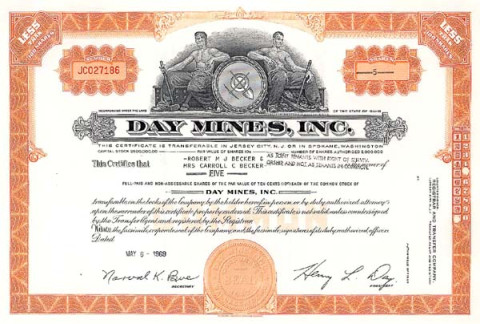
Miner
Henry Lawrence Vincent Day
1902 — 1985
Hank Day (1902-1985) was born in in Spokane, Washington, to Helen Dwyer and Harry Lawrence Day, and grew up in Burke, Idaho, site of the great Hercules mine. In 1905, the family moved to Wallace, Idaho where he remained with the exceptions of when he attended the University of California where, in 1923, he graduated in Mining Engineering. The following year he did post graduate studies in economic geology at Harvard University. In 1937 Henry married Lois Ecius Flohr, and they had a daughter, Barbara, in 1939; on June 6, 1940 Lois died at age twenty-nine of heart disease. Henry remained a widower for many years, employing a Mrs. Cady to look after his daughter, and did not remarry until April 27, 1972 when he married Anne Kearny, an old friend from New Jersey, whose late husband, Thomas, had been a newspaper editor. Henry had been best man at Ann and Thomas's wedding and Thomas was Barbara's godfather.
Hank's father and his uncle, Jerome Day, welcomed him into the family business as they began extricating themselves. The middle of the 1920s was a period of turmoil for the Day family due to the demise of the Hercules Mine, which, for the previous twenty-five years had provided a healthy cash flow for the family's endeavours. Henry gradually streamlined the family operation, bringing it into the modern business community. For example, while consolidating the existing mining companies he branched out into gold mining in northern California in the thirties (a venture which did not pan out particularly well). But the Day companies did do well during World War II because of high metals prices.
Continuing with his streamlining moves, on October 1, 1947, he was successful in forming Day Mines Inc. by having the shareholders of 12 companies vote to form Day Mines Inc. These firms included the Crystal Lead, Dayrock, Duluth, Happy Day, Hercules, King, Monitor, Sherman Lead, Stanley, Tamarack and Custer, Treasure Vault, and Western Union companies. Henry L. Day was a director of all twelve corporations and president and manager of all but the Dayrock, of which he was vice president and manager. Frank M. Rothrock, president of the Dayrock, was a director of all of the twelve and vice president of all except the Duluth and Crystal Lead. The rest of the directors and officers were similarly overlapping, and stockholding in all of the companies was dominated by Day Family members and their close associates. When the new conglomerate was formed, the so-called "Day Interests," which included the Rothrock and Paulsen families of Spokane, held 54 percent of the stock.
Day Mines, Inc., produced five primary metals: lead, silver, zinc, gold, and copper. Their relative contributions to the company's gross profits varied from year to year as metal prices fluctuated and different mines were worked. In 1947 lead was dominant, zinc second, and silver a distant third. Lead gradually declined in relative importance, being replaced in first place before 1958 by gold, mostly from the Republic District of Washington State. For several years gold provided over half the corporate income, but silver reached second place in the mid-1950s and ranked first in all years but one after 1966. In the last half of the 1970s, silver furnished three quarters or more of the gross income, with gold usually in second place. Copper was always last until the Victoria Mine began production in 1980, when with 7 percent of the profits copper nosed out lead and zinc for third place.
As precious metal prices rose rapidly at the end of the 1970s and the beginning of the 1980s, Day Mines, Inc.'s extensive mineral lands, so painstakingly pieced together over the decades, attracted other mining firms. In 1981 Day Mines was America's fifth largest producer of silver. Hecla Mining Co., whose most important property was the Lucky Friday Mine, ranked second; only the Sunshine Mining Co., also active in the Coeur d'Alenes, produced more silver than Hecla. In February 1981, Hecla revealed that it had acquired 5.69 percent of Day Mines stock and intended to obtain more. The Day Mines management vigorously resisted in the courts and in the press, but when on July 8, 1981 Hecla improved its offer to 1.8 Hecla shares for each Day share and promised protection for the jobs of Day employees, the Day directors agreed to recommend acceptance to their stockholders and to withdraw from or abandon all lawsuits against Hecla. Consummated on October 21, 1981, this stock exchange terminated Day Mines, Inc. It cost Hecla Mining Co. $105.8 million at then current stock prices and made Hecla the largest silver mining firm in the United States.
Last Updated on: 2024-02-28
